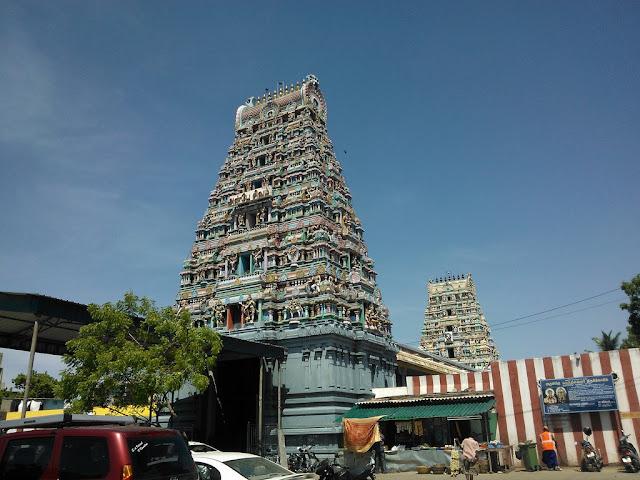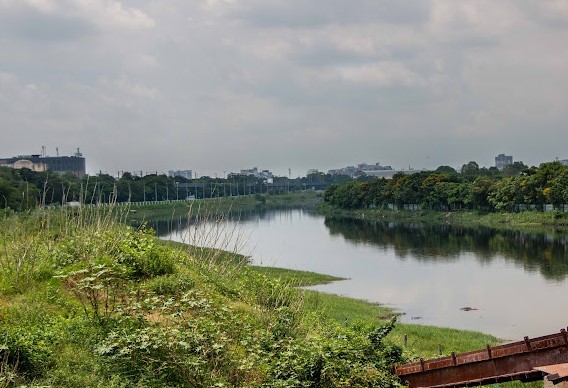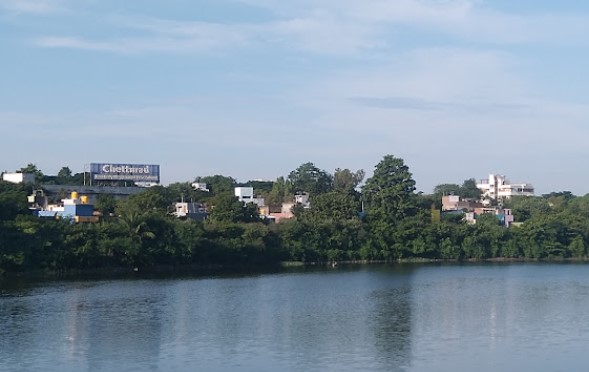- The road starting from Marundeeswarar Temple, now known as the East Coast Road (ECR), was an important route during the Chola period, referred to as Vadagaperuvazhi. This road connected the Chola kingdom to regions in Thanjavur and Andhra Pradesh. Inscriptions found in the shrine of Tripurasundari Amman date back to the 11th century, from the reign of Rajendra Chola, supporting the temple's historical significance. Further corroboration of the temple's antiquity is found in inscriptions at other notable temples in Chennai, such as Kapaleeshwarar Temple, Virupaksheewarar Temple, and Thiruvidandai, which testify to the long existence of Thiruvanmiyur.
- The temple has been revered by famous Saivite poets, including Tirugnanasambandar and Thirunavukkarasar, who visited and sang the praises of the temple around 1200 years ago. Arunagirinathar, the renowned Tamil saint, also visited the temple and composed hymns in praise of Lord Subramanya here.
- The temple, which has a long and rich history, was revitalized in the early 20th century, with significant renovations taking place in 1903 and again in the 1970s. Along with Kapaleeshwarar Temple and Thiruvottriyur Thyagarajaswami Temple, Marundeeswarar Temple forms the celebrated Trinity Sea Shore Temples of Thondai Mandalam.
- In a significant event, during the construction of the East Coast Road, there were plans to demolish the temple of Sage Valmiki, located opposite Marundeeswarar Temple. However, the Tamil Nadu High Court intervened and issued a directive for the temple to remain undisturbed.
- The Kumbabishekam (coronation ceremony after renovation) of the temple was held on 23 May 2008. The construction of the Rajagopuram (main tower) on the eastern side of the temple had begun 45 years ago but was only completed before the Kumbabishekam, with government orders facilitating its completion at a cost of Rs 45 lakh. Additionally, Rs 1 crore was allocated for the improvement of the temple's infrastructure, which included the construction of a new compound wall, Annadanakudam (free meal hall), an office complex, and other amenities for the convenience of devotees.
- The Marundeeswarar Temple is steeped in rich legends and history, one of which highlights the significant role Lord Shiva played in imparting knowledge about medicine and cures. According to tradition, Lord Shiva himself taught the great Sage Agastya about the medicinal properties of herbs and plants at this very shrine. The main deity, a self-manifested Shivalinga, is revered as Marundeeswarar, with the name Marundhu meaning "medicine" in Tamil, signifying Lord Shiva as the God of Medicines. Devotees believe that Lord Shiva bestows blessings upon those suffering from diseases and ailments, using his divine powers to heal and relieve them from their worries.
- A notable legend associated with the temple is the visit of Sage Valmiki, the author of the Ramayana, who came to worship Lord Shiva and seek redemption for his past deeds. It is believed that Sage Valmiki was once a thief, but after engaging in intense penance, he was transformed into an ascetic and blessed for his profound work. The place where he worshiped Lord Shiva came to be known as Thiruvalmikiyur, a name that gradually evolved into Thiruvanmiyur. To honor Sage Valmiki and commemorate his devotion, a locality in Thiruvanmiyur is named Valmiki Nagar.
PURANIC SIGNIFICANCE:
Legends and Significance of Marundeeswarar Temple
Sage Agasthiyar and the Science of Medicinal Herbs
The legend tells that Sage Agasthiyar worshipped Lord Shiva at this temple and was taught the science of “Oushadha Muligai” (medicinal herbs). Because of this, Lord Shiva is known as Sri Oushadeeswarar and Sri Marundeeswarar, where "Marundu" means "medicine" and "Eswarar" means "God" in Tamil. It is believed that Sage Agasthiyar was blessed with Lord Shiva’s wedding darshan under the Vanni tree, the sacred tree of the temple.
Sage Valmiki and the Dance of Lord Shiva
Sage Valmiki, the author of the Ramayana, is believed to have been advised by Sage Narada to visit this temple and worship Lord Shiva for salvation. It is said that Lord Shiva gave darshan to Sage Valmiki under the Vanni tree. On a full moon day in the Tamil month of Panguni, Lord Shiva is believed to have performed his cosmic dance when the sage attained salvation.
Kamadhenu's Worship of Lord Shiva
The divine cow Kamadhenu is said to have
worshipped the lingam at this temple to seek relief from a curse placed upon her by Sage Vashistar. The hoof marks of Kamadhenu can still be seen on the lingam. Since Kamadhenu offered her milk to the Lord, the lingam appears white in color. Therefore, Lord Shiva is also known as Palvanna Nathar, where “Palvannam” means "white as milk" in Tamil.
Worship by Vedas and Devas
It is believed that the Vedas and Devas worshipped Lord Shiva at this temple, and thus, Lord Shiva is also called Sri Vedapureeswarar.
Sage Markandeya's Worship
Lord Shiva is said to have given darshan to Sage Markandeya under the Vanni tree, further adding to the sacredness of the temple.
Worship by Various Deities and Figures
The temple has been worshipped by several prominent figures, including:
- Lords Brahma, Mahavishnu, Ram, Suryan, Chandran, and Sage Birunki
- King Rajendra Chola, a great Chola ruler, is also believed to have worshipped Lord Shiva here.
- Saint Appayya Dhikshithar, a Sanskrit scholar and Advaita Vedanta philosopher, is believed to have worshipped Lord Shiva here. A famous legend recounts that during a flood, when the saint could not approach the Lord’s face for darshan, Lord Shiva turned west to grant him darshan. Because of this, Lord Shiva's shrine faces west, unlike other shrines which face east.
The Name "Thiruvanmiyur" and the Visit of Sage Valmiki
Lord Shiva gave the dance darshan to Sage Valmiki at this temple, and as a result, the place was originally called Thiruvalmikiyur, which eventually became Thiruvanmiyur. A shrine for Sage Valmiki is located in the middle of the ECR, near the main temple.
Lord Shiva Teaching Agasthiyar the Herbal Medicine
Lord Shiva, also called Authastheesar or Marundeeswarar in Tamil, is believed to have taught Sage Agasthiyar the knowledge of herbal medicine here when the sage was suffering from stomach pain.
Worship by Devas and Other Saints
Several divine beings are believed to have worshipped Lord Shiva at this temple, including:
- Devas like Suryan, Brungi, Bharadwaja, and Indra
- Sage Markandeya, who also sought blessings here.
It is believed that Suryan worshipped Lord Shiva during dusk, and therefore, many important temple functions, including Kodiyetram (flag hoisting), are performed at sunset, with the temple facing west.
The Legend of Sage Vasishta and Kamadhenu
In another legend, Sage Vasishta performed severe penance on Lord Shiva. When Kamadhenu, the divine cow, delayed in giving milk, Sage Vasishta cursed her to become an ordinary cow. Kamadhenu came to this temple, worshipped Lord Shiva under the Vanni tree, and poured her milk. In appreciation of her devotion, Lord Shiva relieved her curse, and the Lord became known as Palvanna Nathar ("white as milk").
Marundeeswarar:
Lord Shiva imparted sage Agastya on curative properties of various herbs and plants. Since then the Marundeeswarar temple has been a place of worship for people with diseases and various problems with their health. Hence is also praised as Marundeeswarar – Marundhu in Tamil means medicine and Easwara God – God of Medicines.
Thiruvalmikiyur:
It is said that even The Sage Valmiki, who wrote The Ramayana, came here to The Marundeeswarar temple to worship Shiva and corrected himself from the ways of his past life as a robber. Pleased with the sage, Lord Shiva appeared before him under the Vanni tree in the temple. The place, as requested by the sage, was named after him. The Vanni tree is in the prakara where the Lord granted darshan to Sage Agasthya and Sage Valmiki.
This event forms part of the Panguni Brahmmotsavam in the temple. After this incident, this place was to be known as Thiruvalmikiyur, the name gradually changed to Thiruvanmiyur. There is a place present in Thiruvanmiyur called Valmiki Nagar in his honour. There is also a temple built for Sage Valmiki in the middle of the East Coast Road, very close to the Marundeeswarar temple.
Various Lingams:
The lingam for which Hanuman performed pooja, The lingam (Meenakshi Sundareswarar) that cured the curse of Indra, the Lingam for which Saint Bharadhwaja performed pooja are present here.
Lord facing west:
Appayya Dikshitar, whose original works and commentaries on our sacred books had enriched the Sanskrit literatures and the spiritual heritage of South during the twentieth century, was unable to have the darshan of Lord due to heavy floods. He was able to see only the back of the Lord. He said to the Lord, “I came here to worship you with your face, can’t you oblige me.” Moved by the prayer of Dikshitar, Lord Shiva turned west and granted darshan.
Paalvanna Nathar:
Recognizing the penance of Sage Vasishta on Lord Shiva, Indira sent his Kamadenu the divine cow with the sage. Once, the cow delayed to pour the milk for puja. The angry sage cursed it to become an ordinary cow losing its divine status. He also suggested the cow to go to this place and worship Lord Shiva under the Vanni tree to recover its divinity. Kamadenu poured the milk on the Lord and got back its original supremacy. Hence, the Lord has the name Paalvanna Nathar. Paal in Tamil means milk. When Sage Valmiki came there to worship Lord Shiva, Kamadenu ran in fear pressing its feet on the head of the Shivalinga, the scar of which is still visible on the presiding deity.
Brahma conducted a festival for Lord Shiva here:
Brahma is believed to have conducted a festival here for Shiva.
People worshipped Lord Shiva here:
It is believed that Suryan worshiped lord Shiva during night, hence important functions are held during night including kodiyetram. Ramar, on his way to Lanka worshipped Shiva, Devas worshipped and so he is known as Vedapureeswarar, Moon God got his curse cleared off by worshipping Shiva here and Sage Brinki (in whose name Paranki Malai has come up) worshipped Shiva. Markandeya performed a penance and prayed to Shiva here. Lord Shiva gave Dharshan to Markandeya under the Vanni Tree.
Lord Shiva danced before Sage Valmiki here:
Lord Shiva danced before Sage Valmiki during Panguni full moon day.
Replica of Thiruvarur Thyagaraja:
Thyagaraja of Tiruvarur is said to have been worshipped by Mahavishnu and Indra the King of Gods. Seven shrines associated with Thyagarajar in Tamilnadu are known as the Sapta Vitanka Sthalams. Three replicas of Thyagarajar are found at Thiruvanmiyur, Thiruvotriyur and Thirukkachur.
ADMINISTRATION:
Today, the temple is under the administration of the Hindu Religious and Charitable Endowments Board of the Government of Tamil Nadu.


